| THIS WEEK'S ARTICLES |
| The Mindful Investor |
| Could the QQQ Turn Dramatically Lower? |
| by David Keller |
There is no denying the strength of the bullish primary trend for stocks off the April low. The Nasdaq 100 index continues to make new all-time highs, closing just under $480 on Friday after gaining about 3.5% over the last week. But will this incredible uptrend continue into July and August?
We've been tracking plenty of warning signs, from the dramatic increase in bearish momentum signals to an initial signal from the Hindenburg Omen in late May. But, despite those bearish implications, the strength of mega-cap growth stocks, like Nvidia (NVDA) and Apple (AAPL), has been enough to drive the major equity benchmarks higher. The question for investors is whether the strength in these leading growth stocks will be enough to keep this bullish market trend in place!
Today, we'll lay out four potential outcomes for the Nasdaq 100. As I share each of these four future paths, I'll describe the market conditions that would likely be involved, and I'll also share my estimated probability for each scenario.
By the way, we conducted a similar exercise for the Nasdaq 100 back in February, and you won't believe which scenario actually played out!
And remember, the point of this exercise is threefold:
- Consider all four potential future paths for the index, think about what would cause each scenario to unfold in terms of the macro drivers, and review what signals/patterns/indicators would confirm the scenario.
- Decide which scenario you feel is most likely, and why you think that's the case. Don't forget to drop me a comment and let me know your vote!
- Think about how each of the four scenarios would impact your current portfolio. How would you manage risk in each case? How and when would you take action to adapt to this new reality?
Let's start with the most optimistic scenario, involving the QQQ pushing above $500 over the next six-to-eight weeks.
Option 1: The Very Bullish Scenario
The most optimistic scenario would mean the Nasdaq 100 continues its incredible pace, pushing well above the $500 level by the end of July. Not only would leading growth names continue to thrive in this environment, but other stocks that have not been participating - such as Energy and Industrials - would likely rotate higher as a broader advance propels the QQQ to further new all-time highs.
Dave's Vote: 10%
Option 2: The Mildly Bullish Scenario
What if the market remains elevated, but the pace slows way down? This second scenario would mean that the Magnificent 7 stocks would stall a bit, and perhaps other stocks would rotate higher. The major benchmarks would remain in a primary uptrend, but we'd be talking about leadership rotation as the market remains in a "wait and see" mode about potential Fed rate cuts later in 2024.
Dave's vote: 25%
Option 3: The Mildly Bearish Scenario
Both of the bearish scenarios would involve a pullback in leading growth names, and if leading names like NVDA begin to retrace their gains from early 2024, we could face a mildly bearish scenario. Breadth conditions remain weak and, after the leaders start to fail, there's nowhere to go but lower. In scenario #3, I would expect the May low around $443 to hold for the QQQ, and this begins to feel like a well-deserved pullback while the primary uptrend still remains in place.
Dave's vote: 60%
Option 4: The Super Bearish Scenario
You always need to have a super bearish outcome, which helps to put the other three into proper perspective. In scenario 4, the leadership stocks give back their recent gains, and perhaps some strong economic data brings the whole "Fed Goldilocks scenario" into question. The QQQ drops below its May low, and by late July we're debating whether the April low will hold. While the major equity benchmarks still have positive returns in 2024, this corrective move forces even the most optimistic of bulls to reconsider their thesis.
Dave's vote: 5%
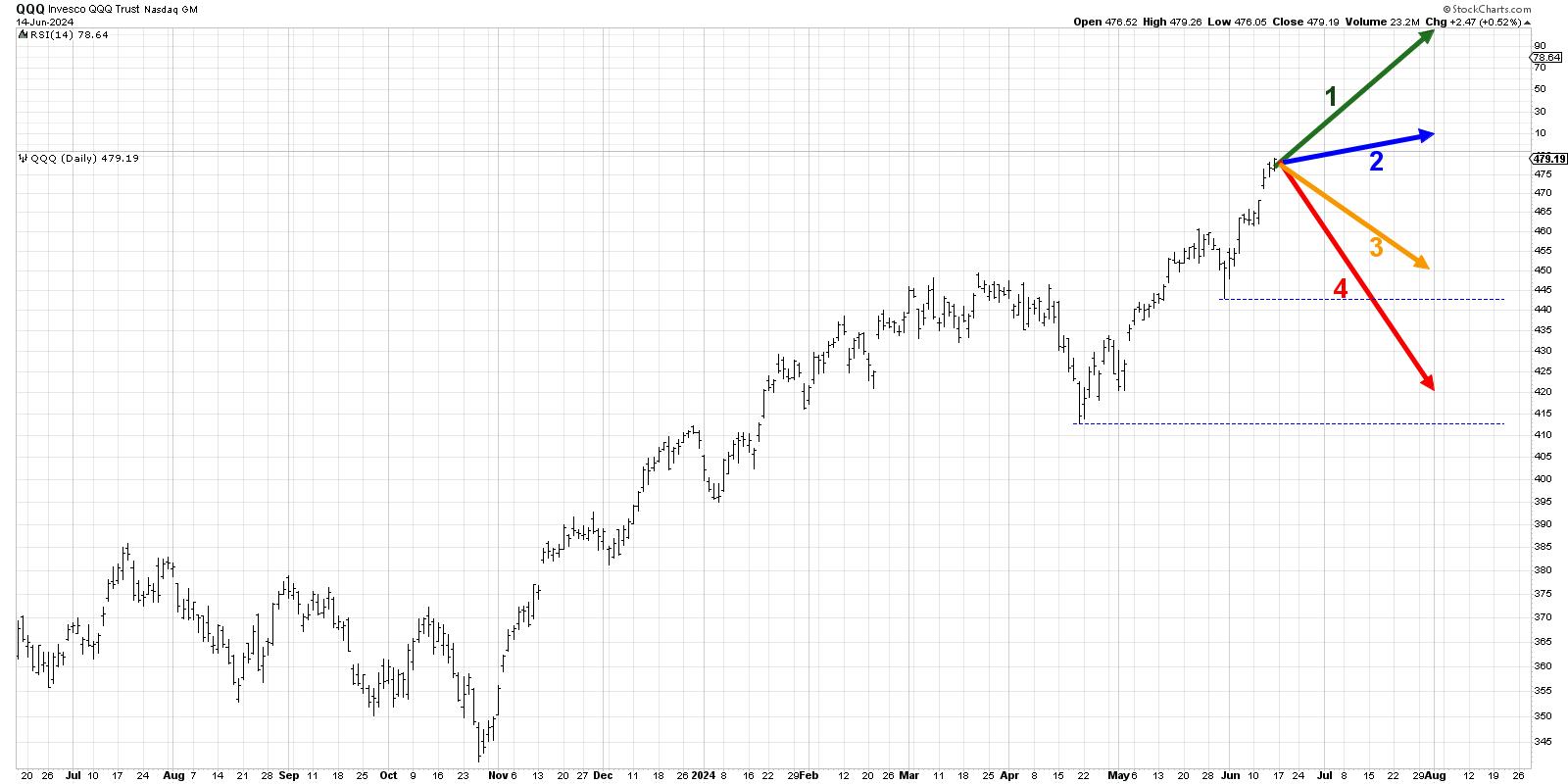
What probabilities would you assign to each of these four scenarios? Check out the video below, and then drop a comment with which scenario you select and why!
RR#6,
Dave
P.S. Ready to upgrade your investment process? Check out my free behavioral investing course!
David Keller, CMT
Chief Market Strategist
StockCharts.com
Disclaimer: This blog is for educational purposes only and should not be construed as financial advice. The ideas and strategies should never be used without first assessing your own personal and financial situation, or without consulting a financial professional.
The author does not have a position in mentioned securities at the time of publication. Any opinions expressed herein are solely those of the author and do not in any way represent the views or opinions of any other person or entity.
|
| READ ONLINE → |
|
|
|
| Martin Pring's Market Roundup |
| MEMBERS ONLY |
| The Next Direction for Interest Rates Is...? |
| by Martin Pring |
|
In most cycles, central banks around the world raise and lower short-term interest rates in a rough synchronization. Last week, the European and Canadian central banks began lowering their rates, and the British are expected to follow suit this week...
|
| READ ONLINE → |
|
|
|
| Art's Charts |
| Alibaba Returns to the Scene of the Crime |
| by Arthur Hill |
Chinese stocks wet on a tear from mid April to mid May with the China Large-Cap ETF (FXI) gaining some 40% and breaking its 200-day SMA. FXI then fell back over the last few weeks. This surge and pullback created a potential opportunity because some stocks returned to their breakout zones. These so-called throwbacks offer traders a second chance to partake in the breakouts. Today's example will show Alibaba (BABA), which was featured on ChartTrader this past week.
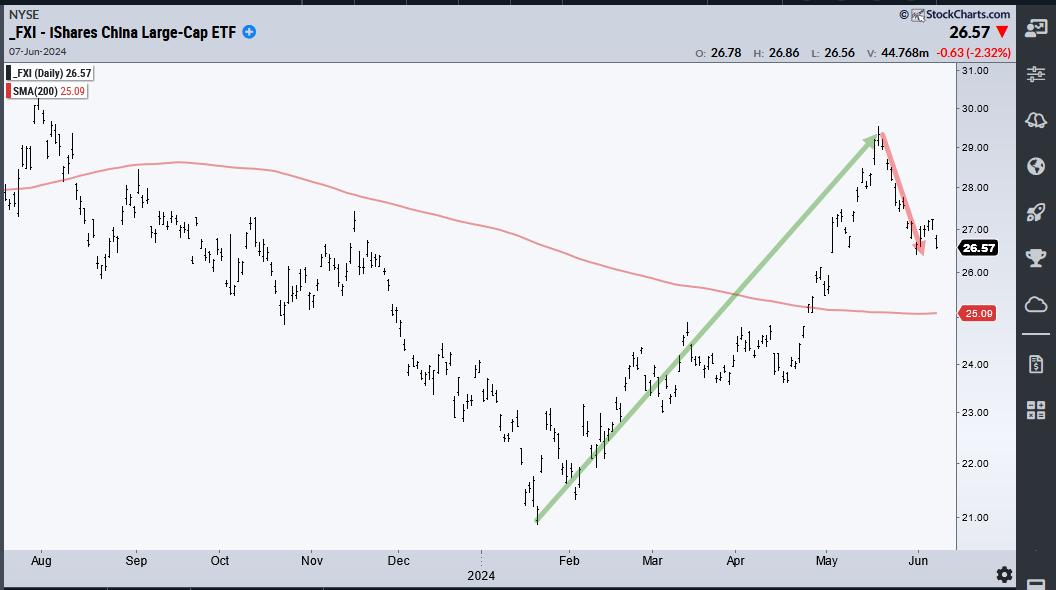
The chart below shows Alibaba with the 200-day SMA (red line) and the Trend Composite in the indicator window. On the price chart, BABA found support twice in the 67-68 area and broke resistance with a surge in May. The two lows in this area formed a Double Bottom and the breakout reversed the downtrend. Also notice that BABA broke the 200-day SMA.
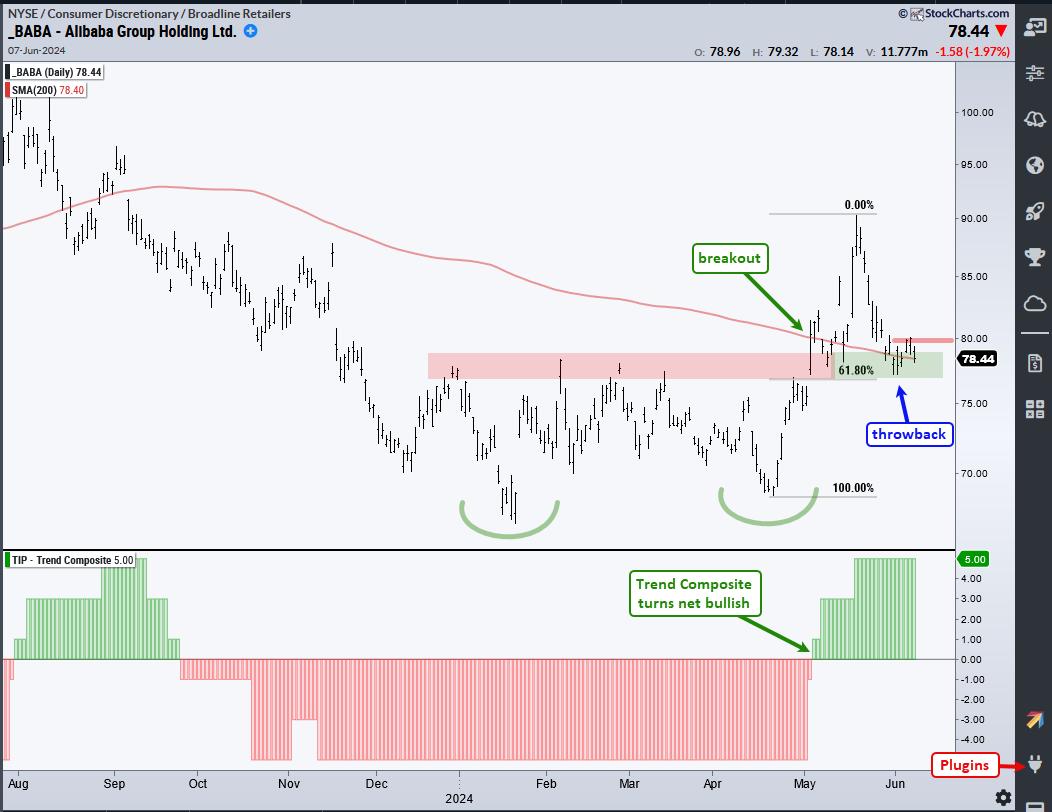
Traders who did not catch the breakout have a second chance because BABA returned to the breakout zone in early June. This is a classic "throwback" to broken resistance, which turns into support. The stock also returned to the 200-day SMA and the decline retraced around 61.8% of the prior surge. This retracement is normal for a pullback within a bigger uptrend. Overall, I see a Support-Reversal Zone in the upper 70s and I am watching short-term resistance at 80. A breakout here would reverse the short-term downswing and argue for a resumption of the bigger uptrend.
As noted above, the indicator window shows the Trend Composite, which aggregates signals in five trend-following indicators. It moved to +1 in early May, which meant three of the five indicators triggered bullish signals (3 - 2 = +1). Two more indicators turned bullish by the end of May and all five are now bullish (+5). My strategy is to look for tradable pullbacks within bigger uptrends. The Trend Composite signals a long-term uptrend and the decline to the upper 70s is a tradable pullback. Note that this indicator is part of the TIP Indicator Edge Plugin for StockCharts ACP (click here).
ChartTrader at TrendInvestorPro featured BABA and two other Chinese names last week. Recent breakouts in several crypto-related names were also featured because their breakouts signaled a continuation of their bigger uptrends (IBIT, COIN, BLOK). Reports and videos are published twice per week. Click here to learn more.
//////////////////////////////////////////////////
|
| READ ONLINE → |
|
|
|
| OptionsPlay |
| A Debit Spread in American Express to Add Long Exposure |
| by Tony Zhang |

As consumers become more selective in their spending, restaurants and travel remain bright spots in consumer spending. With American Express's focus on premium customers who continue to spend in these categories, AXP is positioned to outperform its industry. As they focus on a younger customer base and grow their presence in international markets, AXP has acquired new customers at an accelerated pace.
If you look at a chart of AXP below, you can see it's had an incredible run over the past year, rallying nearly 60% from the Oct 2023 lows, and recently, pulling back 8% from its peak a few weeks ago. As momentum, measured by the Relative Strength Index (RSI), starts to reach oversold conditions, this presents a more attractive risk/reward for adding long exposure within this strong bullish trend.
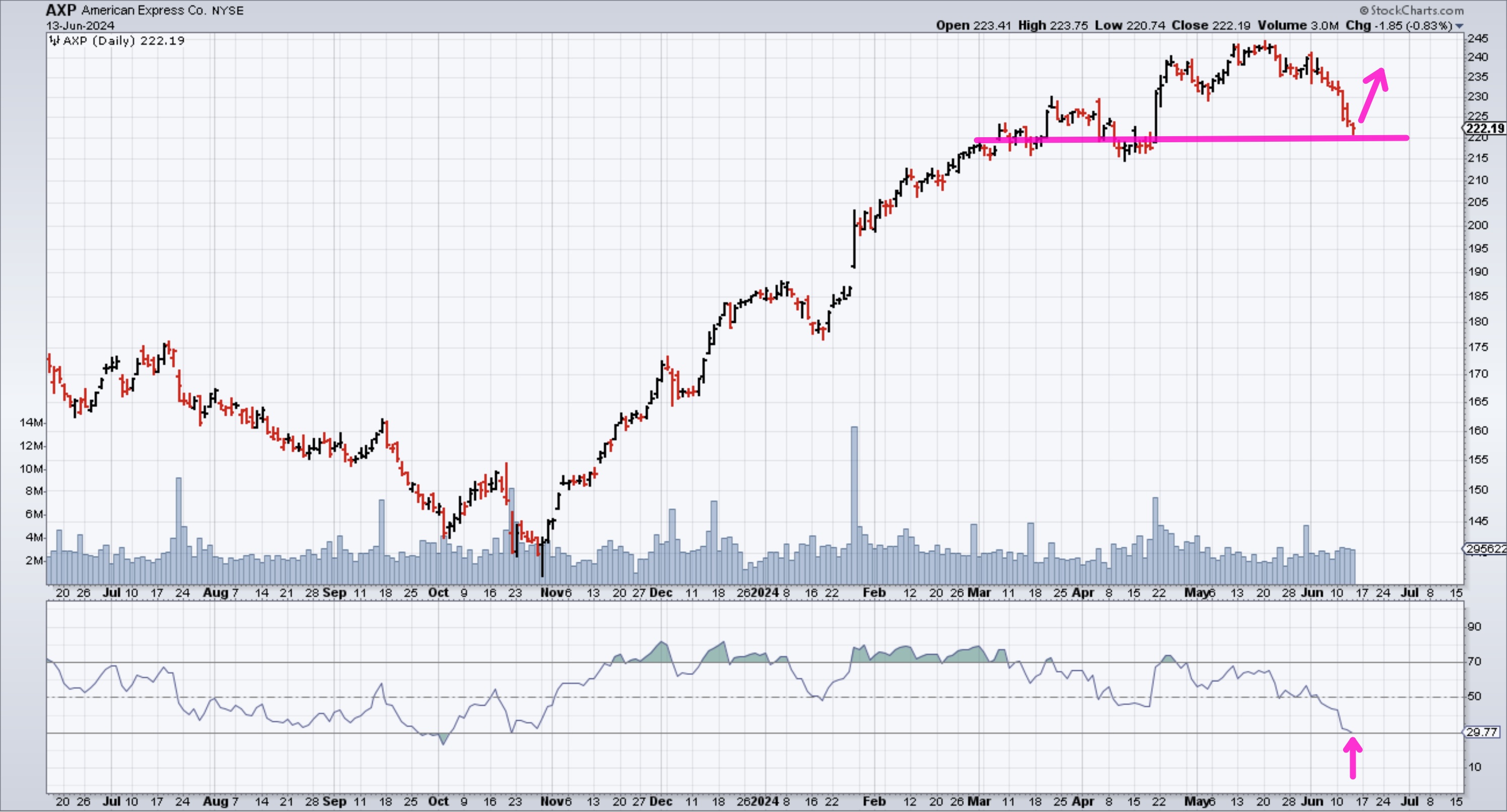
CHART 1. DAILY CHART OF AMERICAN EXPRESS. The RSI is oversold, presenting a more attractive risk/reward scenario for adding long exposure.Chart source: StockCharts.com. For educational purposes.
Shifting over to the business, AXP is expected to grow earnings-per-share (EPS) at an above-average clip of 15% and revenue at 9%, yet it trades at a 12% discount to the average S&P 500 stock. With net interest income and card fees expected to grow, this discount reflects the upside opportunity for AXP to trade back towards its 52-week highs and beyond.
With IV Rank @ 16%, options are not cheap, but also not expensive. In this scenario, because there isn't a catalyst over the next few weeks, I prefer buying an ITM debit spread, which would minimize the time decay that I would have to pay for upside exposure. This would involve the following:
- Buying the August $220 Calls @ $10.80
- Selling the August $240 Call @ $3.00
This strategy would risk $780 per contract if AXP is below $220 at expiration, while potentially profiting $1,220 per contract if AXP rallies above $240 at expiration (see below).
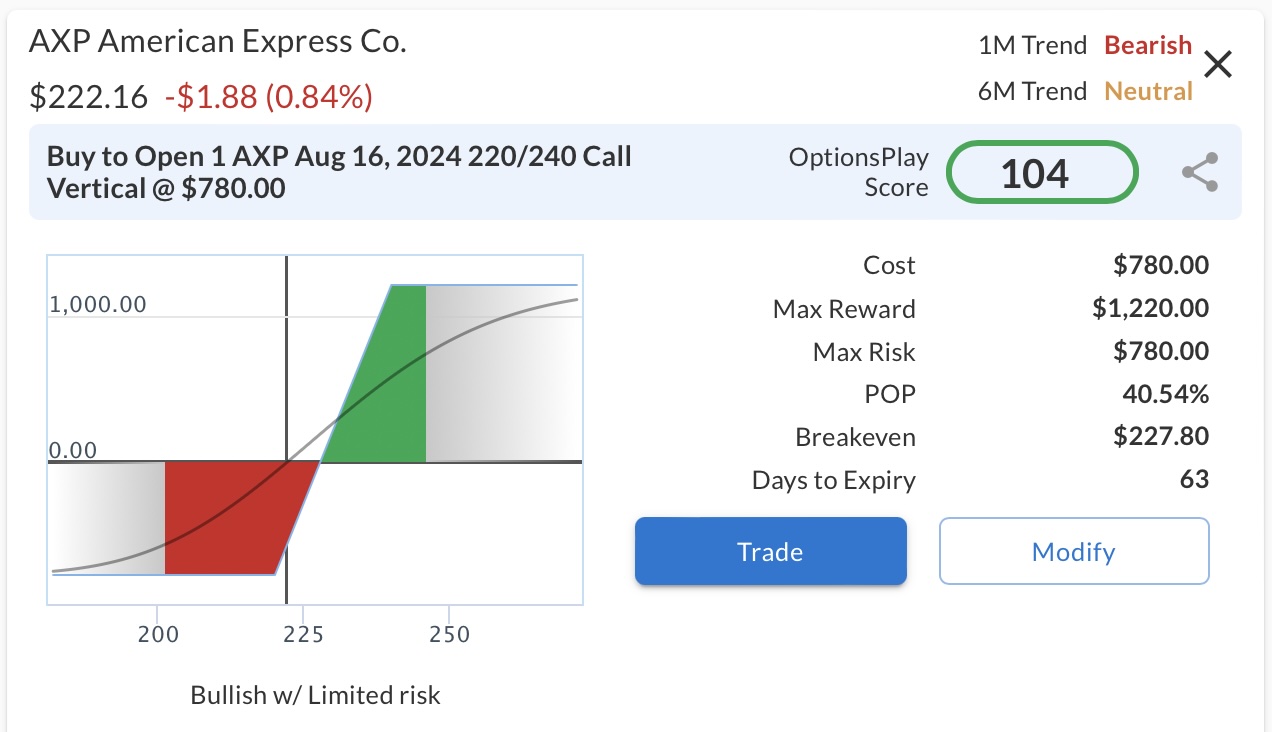

|
| READ ONLINE → |
|
|
|
| The Traders Journal |
| How to Stop the "Wealth Destroyers" by Deploying Your Sell Methodology |
| by Gatis Roze |
"We are in the business of making mistakes. Winners make small mistakes. Losers make big mistakes." — Ned Davis
 There are zillions of cliches that paraphrase what Ned Davis said. The umbrella axiom with your portfolio should be to cut your losers. There are zillions of cliches that paraphrase what Ned Davis said. The umbrella axiom with your portfolio should be to cut your losers.
Nude investing is what I label an investor without a formalized selling methodology. I refer to myself as a rational investor, and by that I mean I blend fundamental analysis (particularly earnings) with my technical analysis tools. Doesn't that seem reasonable or rational? Well, having a specific sell methodology is both rational and necessary.
Not to name names, but I've witnessed numerous prominent fundamentally-oriented money managers preaching to individual investors how complex investing is, and, for this reason alone, investors cannot possibly succeed on their own, but should therefore entrust their assets to these fundamentalist managers. Oftentimes, the parallel sermon is that charts and technical analysis is just "hocus-pocus".
I will concede that, on the buy side, sound fundamentals certainly increase the probability of a profitable investment. On the sell side, it's tomfoolery for these same fundamentalists to claim this as gospel, because the majority of these same money manager preachers are closet chartists. Shocking, but true. Yes, they use charts to decide when to sell. The reality is that your wealth will get destroyed if you use only fundamentals in your selling methodology. Fundamentals are always late to the sales party. Your charts are real-time.
Sell based on the charts. It's the foundation of profitable investing. You'll learn "why" weeks or months after the equity has drifted lower and lower. Once again, sell based on the charts and ask questions later. Protect your profits at all costs. Get your ego out of the way.
As Ned Davis said, we are in the business of making mistakes. It's to be expected. Just make certain they are small mistakes. Isn't this a life lesson as well?
So how do you make these SMALL mistakes? To that end, I'll present four examples of "wealth destroyers" most investors are familiar with. I'll show you how applying my 3-Peaks selling methodology would have saved your kit and caboodle. In the selling chapter of our book (Tensile Trading), we refer to it as the Beginner's Sell Methodology. It has three major advantages: it's simple, it's clear, and it works.
Here's the discipline. When an equity makes a new price high, followed by a pullback, and then the next rally in price fails to take out or exceed the previous high in price, we then have in place 2-Peaks. Yellow flags go up at this point because the second peak is lower than the first peak. Subsequently, a red flag goes up when we have a second pullback, followed by a third peak which is even lower than the previous two peaks. This show of weakness and lessening demand for the equity is your red flag signal to get your finger on the sell trigger. Look at the charts below — LUMN, AIG, Citigroup and Walgreens — and this will make sense.
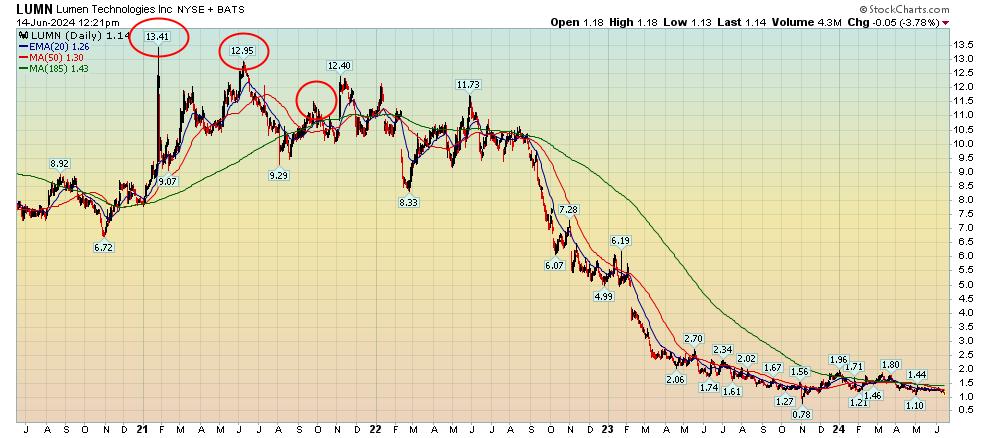 Lumen Technologies (LUMN) Lumen Technologies (LUMN)
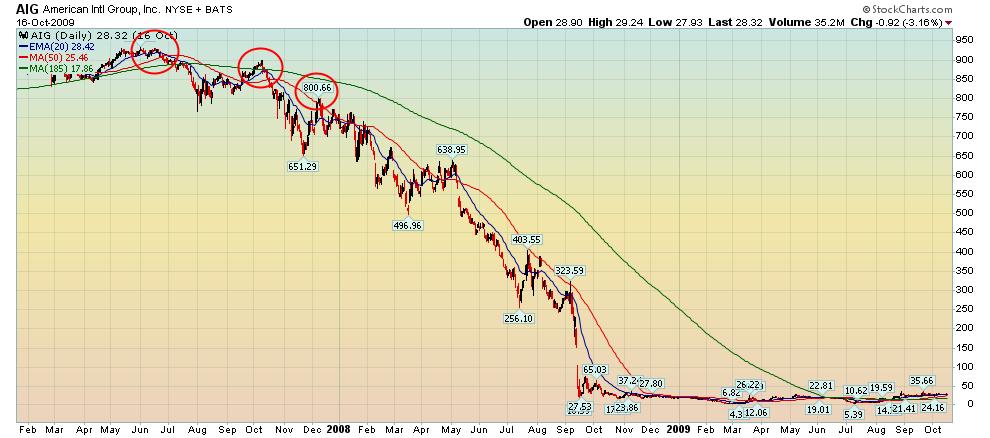 American International Group (AIG) American International Group (AIG)
 Citigroup (C) Citigroup (C)
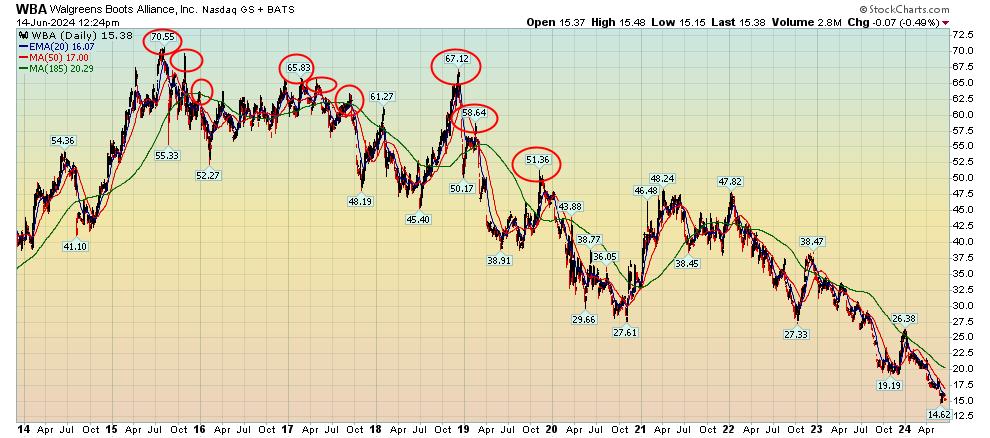 Walgreens Boots Alliance (WBA) Walgreens Boots Alliance (WBA)
In a famous interview that Paul Tudor Jones did with Tony Robbins, the Market Wizard famously said that the key to his success was his ability to play defense and get out of losing positions in a timely manner. Paul Tudor Jones had unbelievable success in managing money. He told his college students that one of his key metrics was the 200-Day Moving Average, but we'll go into that in my next blog. I'll close with a quote from another great Market Wizard (see Jack D. Schwager's books on Market Wizards published by John Wiley & Sons), in which Stanley Druckenmiller maintained that "A big part of my process is taking signals from markets. I've always believed markets are smarter than I am." To this, I would add the caveat that charts don't lie. Learn to trust them.
So here's your homework for next time. Go to StockCharts.com and the Predefined Scans. Find 50 equities making new lows. Go backwards in time and look at their charts when the equity peaked. Then look for two subsequent lower peaks and identify the point at which you would have sold it. Trust me — this will be an hour of power for you. The insights will be well worth your time!
As you do these exercises, try to get into the mindset that the market is selling you clues. The more clues you buy, the lower the price and the lower your profits. Depending upon the specific equity, these chart clues accumulate in different timeframes. Nevertheless, these little red flags will raise their little red heads — some more quickly than others, which is another clue unto itself about the seller's urgency. But usually, the 3-Peaks will be clearly visible. When you see the 3-Peaks pattern, don't just sit there frozen like a deer in the headlights waiting for the apocalypse. This is your call to action.
Remember that profits are the result of two decisions. You can buy wrong and still make money. You can't make money if you sell wrong. Avoiding financial face-plants is an investment discipline embraced by all the Market Wizards. You need to join the club!
"Markets are never wrong, only opinions are." — Jesse Livermore
|
| READ ONLINE → |
|
|
|
| ChartWatchers |
| Stock Market Pushes Higher, But Is There a Bond Market Surprise Brewing? |
| by Jayanthi Gopalakrishnan |

Well, the awaited CPI came in cooler than expected. The stock market liked what it heard, and equities rallied. So did bond prices. Later in the day, the Fed announced its interest rate decision, which, as expected, was unchanged.
More importantly, the Fed's Summary of Economic Projections implies a quarter percentage point rate cut this year. The stock market has priced in more than one rate cut in 2024, yet the broader equity indexes didn't react much to this news.
Thursday's lower-than-expected PPI and an uptick in weekly jobless claims may have added more optimism for equities. Both support the interest rate cut narrative. The S&P 500 ($SPX) and Nasdaq Composite ($COMPQ) closed at new highs.
It doesn't seem like there's much that will come in the way of the market's path to pushing higher. Pullbacks have been mild, the CBOE Volatility Index ($VIX) is low, and the AI frenzy continues. There's no reason to start cutting rates when the going is good. Looking at past interest rate cycles, you'll see that interest rate cuts happen when an economy slows down; so far, we're not seeing any signs of that happening.
Bond Bonanza
The price action in bonds has been interesting. As Treasury yields decline, bond prices rise. The daily chart of the iShares 20+ Year Treasury Bond ETF (TLT) below broke above the downward-sloping blue dashed trendline on June 3. The next day, TLT broke above its previous high (May 16) of around $92. A few days later, TLT pulled back, but still stayed above the downward-sloping trendline.
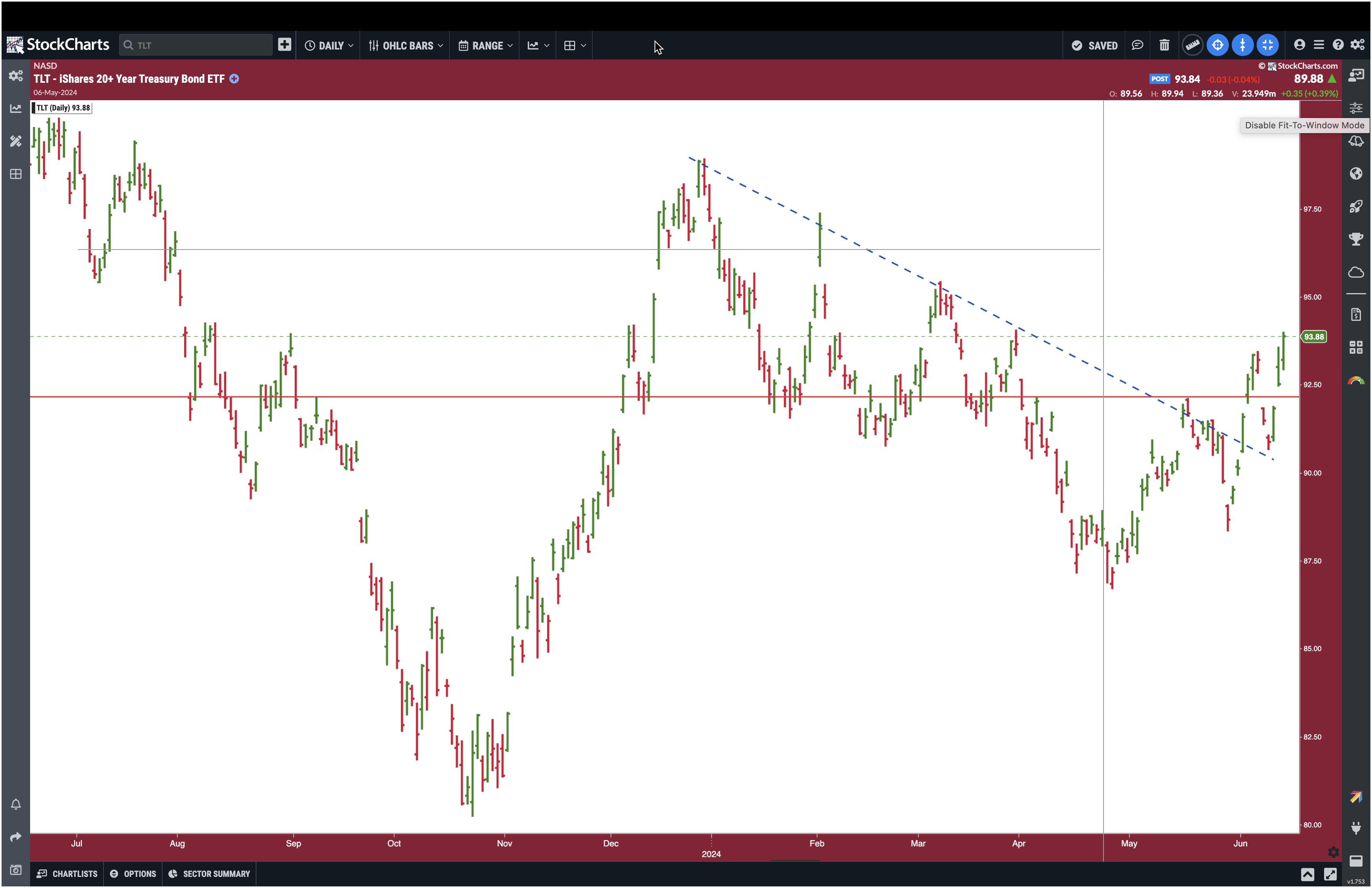
CHART 1. DAILY CHART OF TLT. The ETF broke above its downward-sloping trendline and above its previous May high.Chart source: StockChartsACP. For educational purposes.
After Wednesday's double-whammy economic data day, TLT has continued higher. Thursday's price action is pretty convincing that bonds may have started their climb higher. Does it mean it's time to jump into bonds? The price action in TLT may have to do with the successful 30-year bond auction, so it's best to wait and see what happens in the next couple of days.
What's Up With AAPL and TSLA?
Circling back to the equities space, there's been some interesting activity in specific stocks. Apple, Inc. (AAPL) saw its stock price soar on news of its AI partnership. After a pretty disappointing past few years, AAPL is now back in the spotlight.
The weekly chart of AAPL shows how the stock price traded within a consolidating channel in 2022, broke above that channel in 2023, and then traded sideways for most of 2023 and 2024, until this week. The stock broke above its December 2023 high and hit new highs.
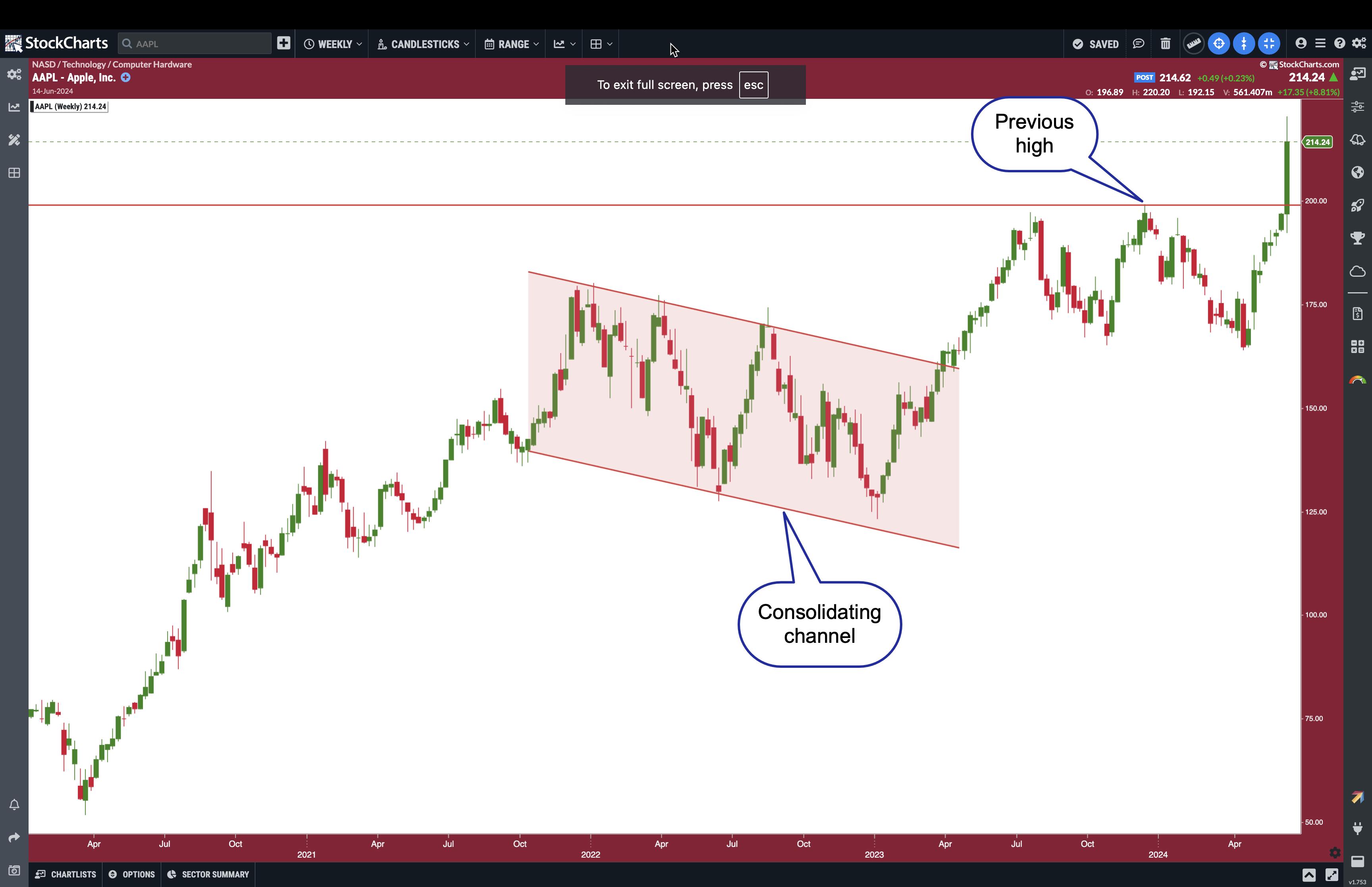
CHART 2. WEEKLY CHART OF APPLE STOCK (AAPL). After breaking out of a consolidation channel in 2022, AAPL traded sideways for almost a year before breaking above its previous high in December.Chart source: StockChartsACP. For educational purposes.
A pullback in AAPL would be a good time to get into the stock, especially if you missed this rally.
Another stock in the news is Tesla, Inc. (TSLA), another S&P 500 stock that took a beating. Today's news about Tesla investors approving Elon Musk's pay package highlighted the stock. TSLA's stock price gapped up but closed near its low. The company faces headwinds such as tariffs on EVs, slowing EV demand, and increased competition.
Technically, TSLA's stock price has broken above a consolidation pattern on above-average volume (see chart below). It's also trading above its 21-day exponential moving average (EMA).
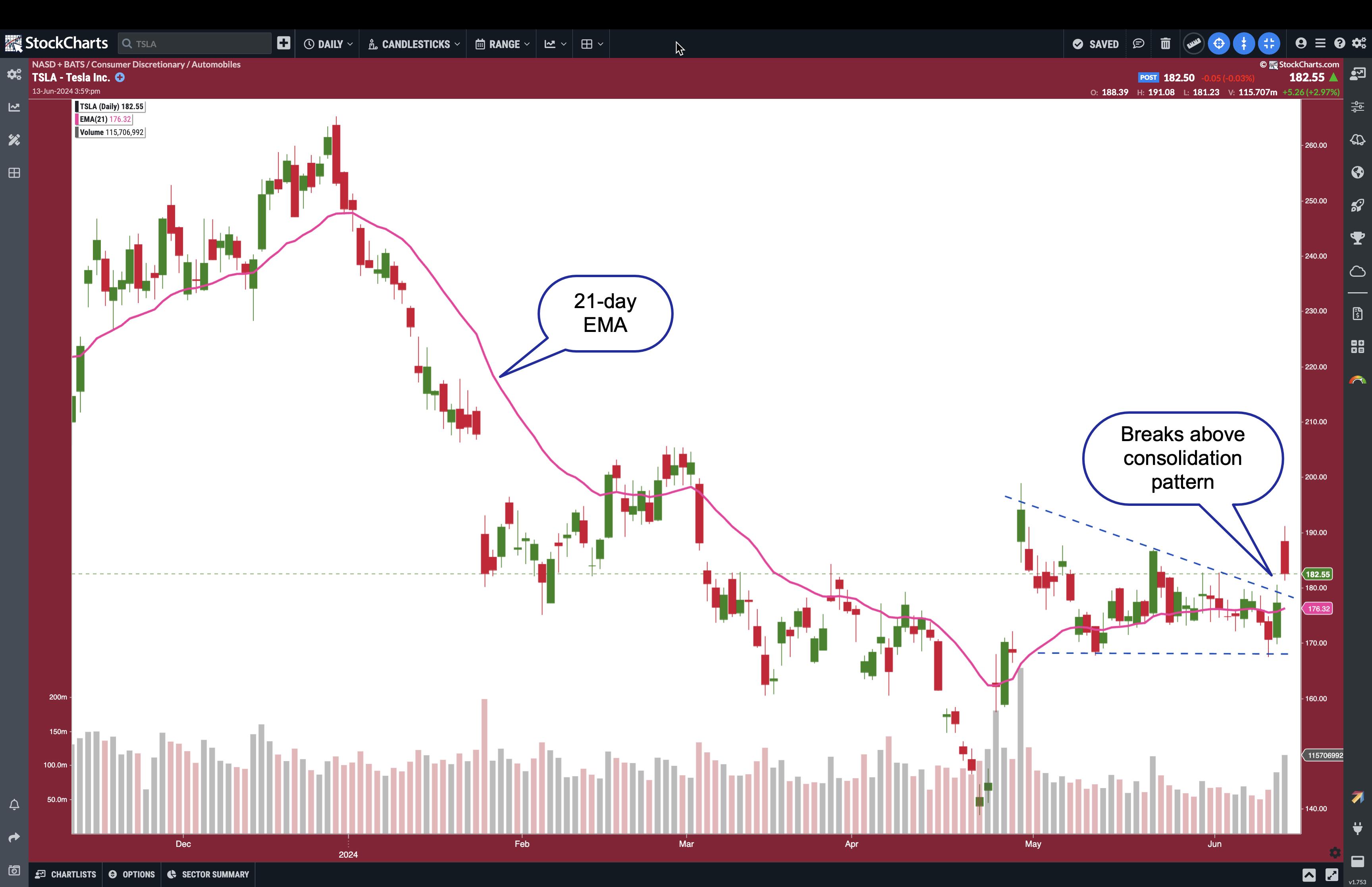
CHART 3. DAILY CHART OF TSLA STOCK. Will the stock price rise if the CEO gets his pay package approval? One day's price action doesn't justify a trend, but it's worth following the stock.Chart source: StockChartsACP. For educational purposes.
We'll know tomorrow if Musk gets his pay package. The outcome will impact TSLA's stock price. Tomorrow ends another trading week. When it comes to large-cap stocks, there are no technical signs of a reversal. Tomorrow may be more of the same. There could be a mild selloff at the end of the trading day, or we could see buyers return. We've seen that happen recently, so don't rule it out.

Disclaimer: This blog is for educational purposes only and should not be construed as financial advice. The ideas and strategies should never be used without first assessing your own personal and financial situation, or without consulting a financial professional.
|
| READ ONLINE → |
|
|
|
| Don't Ignore This Chart! |
| Bitcoin, Politics, and Profits: What You Need to Know About CleanSpark and Riot Platforms |
| by Karl Montevirgen |

While money (the thing itself) knows no politics, its production and distribution are often soaked in it. While Bitcoin isn't a functioning currency, many consider it an antidote to "bad money." Perhaps that accounts for its 3.85% spike earlier in the week.
What Fueled Bitcoin's 3.85% Spike?
A certain presidential contender (on a social media network owned by that contender) expressed his desire for all remaining Bitcoin to be mined in the United States.
He positioned this as a strategic move (and last line of defense) against central bank digital currencies (CBDCs). Furthermore, he stated that domestic Bitcoin mining would help the US become energy-dominant.
A Tale of Two Miners: CleanSpark and Riot Platforms
90% of all Bitcoin has been mined. This presidential candidate wants the remaining 10% to be mined in the U.S. Moreover, he met with executives of both firms to discuss the potential launch of this initiative.
So, if he wins his seat in the White House in November and makes good on his promise, what might this mean for the two leading Bitcoin mining companies in the US—CleanSpark Inc. (CLSK) and Riot Platforms (RIOT)? Could this be among the biggest trading opportunities in the coming year?
CleanSpark: The Invisible Underdog?
While Riot Platforms (RIOT) happens to be the more popular of the two Bitcoin miners, CleanSpark, the clear underperformer, and underdog happens to be trading at a significantly higher PE Ratio of 119.92, according to StockCharts' Symbol Summary tool.
CleanSpark's relative performance against Bitcoin ($BTCUSD) and Riot Platforms (RIOT) is dismal, as shown in the panel below the chart (see chart). Yet it started trading at a high multiple relative to its earnings. Its SCTR score, however, has risen above 90, signaling bullishness across multiple timeframes and indicators.

CHART 1. WEEKLY CHART OF CLSK. A clear underperformer, its PE Ratio and SCTR score are flashing warning signs for potential upside.
Also, the StockCharts Symbol Summary shows CLSK popping up on several bullish scans (see below).

The biggest driver for this particular stock is likely to be this year's election outcome. That's still several months away, but, if you do want to get in early on a trade that's reliant on the outcome, the following are the levels to watch:
- For any bullish thesis to remain valid, CLSK must stay above the support line (see red dotted line), resting just below $14.00.
- This support level coincides with the most recent swing lows and highs (resistance) in 2023, 2022, and 2020.
- For the uptrend to continue beyond the current congestion level, CLSK must break and close above resistance at $24.00, marking its current swing high and October 2021 high.
- If CLSK surges past $24.00, then the next level of resistance appears clear up to $42; however, this is a trade based on politics and geopolitics, perhaps more so than fundamentals of technicals, so bulls will have plenty of homework to do once they're in the trade.
And, if you're wondering how CLSK has performed earnings-wise, Symbol Summary gives you that info as well (see below).

And it looks pretty decent.
Riot Platforms (RIOT): Popular But Problematic
Riot Platforms is the more popular of the two and the better performer.
Like CleanSpark, Riot Platforms is severely underperforming Bitcoin, to which it was once correlated (see lower panel of chart). But unlike CleanSpark, RIOT's woeful SCTR score of 20.8 (top panel) is on the extreme negative side of the spectrum.

CHART 2. WEEKLY CHART OF RIOT. Lots of technical headwinds above. Plus, it holds an incredibly weak SCTR score. So much for the popular stock?
The following is what to look out for:
- RIOT is currently hovering at the bottom end of the trading range—the support level at $8.60.
- A break below this level would be enough to invalidate any bullish bias.
- For an uptrend to take place, RIOT would have to close above $18.75 at the least, and it would have to do so on high momentum.
- Note that above this level, there are several more levels of technical resistance (see dotted blue lines) which may serve both as profit targets and headwinds (for those looking to hold on to RIOT for the longer term).
Fundamentally, RIOT has a few problematic issues.
While trading with a low PE Ratio of 13.60, which can be promising, depending on how you look at it, its StockCharts Symbol Summary also tells a story of how its earnings beats and revenue misses contrast from CleanSpark.

In short, its quarterly revenue reports don't look so hot compared with CleanSpark.
Traders Poised to Pounce on Both Stocks
This year, the high targets for Bitcoin range from $80,000 to $90,000, driven by institutional investment, the halving of Bitcoin, a more favorable regulatory environment, and, now, negative sentiment regarding the development of a digital dollar (CBDC).
Depending on the results of the coming election, the latter may intensify, sending Bitcoin, CleanSpark, and Riot Platforms to much higher valuations. In short, the political environment can rapidly change the fundamental and technical conditions surrounding these stocks. Pay close attention if you want to take advantage of this potential run, as traders may jump the gun on either or both.
The Takeaway
Wrapping things up, the recent 3.85% spike in Bitcoin's value can be attributed to a presidential contender's promise to ensure the remaining 10% of Bitcoin is mined in the U.S., positioning it as a defense against central bank digital currencies.
This potential political shift could significantly impact the U.S. Bitcoin mining industry, particularly CleanSpark Inc. and Riot Platforms. If you want to buy shares of either, you should closely monitor political developments and key support and resistance levels for potential entry points.

Disclaimer: This blog is for educational purposes only and should not be construed as financial advice. The ideas and strategies should never be used without first assessing your own personal and financial situation, or without consulting a financial professional.
|
| READ ONLINE → |
|
|
|
| DecisionPoint |
| DP Trading Room: Equal-Weight Losing Against Cap-Weight SPY |
| by Erin Swenlin |

Did you know that the equally-weighted RSP is seriously underperforming the cap-weighted SPY? It is losing considerable ground against the SPY and that suggests that if mega-caps fail, so will go the market. Carl shows us charts to prove his point.
Next up Carl covers the market in general followed by a review of the Magnificent Seven. Their performance is even more important given they are holding the indexes together.
Erin follow up with a review of the sectors and in depth coverage of the Technology sector. The program concludes with viewers symbol requests. Is it time to buy or sell your stock?
Erin will be doing a special presentation on Wednesday called "When to Sell Your Stock or ETF?". It is free, simply click on this special link to sign up! If you haven't already, we recommend you sign up for our free email list on our homepage at DecisionPoint.com!
Schedule:
01:10 DP Signal Tables
05:42 Discussion of RSP v. SPY
08:08 Market Bias and Market Coverage
14:21 Magnificent Seven
27:22 Sector Rotation
32:40 Symbol Requests
Don't miss Erin's presentation, "When to Sell Your Stock or ETF?" on Wednesday. Sign up for our free email list on our homepage for more information, or use this LINK to register for the presentation.
Want to try out DecisionPoint.com publications for free? Sign up for any DP publication or Bundle package and use coupon code: DPTRIAL2
Watch the latest episode of the DecisionPointTrading Room on DP's YouTube channel here!

Try us out for two weeks with a trial subscription!
Use coupon code: DPTRIAL2 at checkout!
Technical Analysis is a windsock, not a crystal ball. --Carl Swenlin
(c) Copyright 2024 DecisionPoint.com
Disclaimer: This blog is for educational purposes only and should not be construed as financial advice. The ideas and strategies should never be used without first assessing your own personal and financial situation, or without consulting a financial professional. Any opinions expressed herein are solely those of the author, and do not in any way represent the views or opinions of any other person or entity.
DecisionPoint is not a registered investment advisor. Investment and trading decisions are solely your responsibility. DecisionPoint newsletters, blogs or website materials should NOT be interpreted as a recommendation or solicitation to buy or sell any security or to take any specific action.
Helpful DecisionPoint Links:
Trend Models
Price Momentum Oscillator (PMO)
On Balance Volume
Swenlin Trading Oscillators (STO-B and STO-V)
ITBM and ITVM
SCTR Ranking
Bear Market Rules
|
| READ ONLINE → |
|
|
|
| MORE ARTICLES → |
|








 There are zillions of cliches that paraphrase what Ned Davis said. The umbrella axiom with your portfolio should be to cut your losers.
There are zillions of cliches that paraphrase what Ned Davis said. The umbrella axiom with your portfolio should be to cut your losers.

























